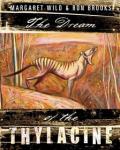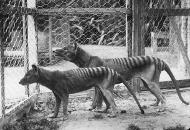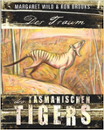AustLit
Latest Issues
AbstractHistoryArchive Description
Adaptations
- The Dream of the Thylacine 2013 single work drama children's
Affiliation Notes
-
Thylacines and the Anthropocene
The Dream of the Thylacine weaves a complicated narrative, juxtaposing archival images of a captured thylacine—hemmed in on the page by wood and chicken wire—with illustrated dreamscapes of the animal free in its wild habitat.
The thylacine narrator speaks four times: at first, it rages fiercely against its 'cage of twisty wire, cold concrete'. 'Know you not,' it insists, aligning the reader with its human captors, 'that I am tooth and claw'. This structure repeats as the narrator grows more and more weary. The verbal phrase 'prowl rage howl' gives way to 'mourn ache yearn', before eventually the thylacine is left 'thin still mute'.
With each insistence by the thylacine that we cannot and do not know its true nature, Margaret Wild and Ron Brooks gesture gently towards the challenges of human-nonhuman understanding. Though readers will guess that the thylacine has likely died in captivity, as the last known thylacine did in 1936 (see Author's Note), the narrator explains that it is actually at rest: "Dreaming am I".
This statement is deceptively simple. It gives the reader hope that other thylacines may have escaped extinction, living on in the wilds of lutruwita / Tasmania. More significantly, the use of the word 'dreaming' here evokes other ways of knowing and engaging ethically in the world, specifically First Nations' Dreaming stories. Brooks' final illustration punctuates this beautifully, with a mountain curling in soft valleys and striped gulleys to form the shape of a sleeping thylacine.
This work is affiliated with the Thylacines and the Anthropocene dataset, tracking thylacine extinction and ecological themes in Australian literature.
Publication Details of Only Known VersionEarliest 2 Known Versions of
Works about this Work
-
Some Thoughts On the (Im)Possibilities of Teaching Australian Literature
2021
single work
criticism
— Appears in: Australian Humanities Review , May no. 68 2021;'In 2008, fervent public debate followed the announcement that the new national Australian Curriculum, then in early development, would mandate the study of Australian literature for all students ‘across the compulsory years of schooling’ (Davies, Martin and Buzacott 21). Conservative commentators welcomed what they saw as assurance that ‘young Australians’ would learn ‘to appreciate, value and celebrate this nation’s identity and history’ (Donnelly, ‘A Canon’). More progressive voices argued that rather than the texts to be read, focus should be on practices of reading that respond to ‘students’ needs, interests and experiences as national and global citizens’ (Davies 47-8). Conservatives were less enthused by the final language of the new curriculum: in Quadrant, self-proclaimed ‘culture warrior’ Kevin Donnelly complained that it had replaced the Western canon and Judeo-Christian morals with ‘politically correct perspectives’, likely the three cross-curriculum priorities: Aboriginal and Torres Strait Islander histories and cultures, Asia and Australia’s engagement with Asia, and sustainability (Donnelly, ‘The Ideology of the National English Curriculum 28, 27; ACARA, ‘Cross-curriculum Priorities’). Australian Curriculum: English is separated into three strands, ‘language’, ‘literature’ and ‘literacy’, each with an enormous set of extensively detailed descriptors, outcomes and performance indicators (ACARA, ‘English’). Teachers and educators worried that its unwieldiness would create a ‘culture of compliance and checking off… content’ that in turn risked extinguishing students’ capacity for ‘creativity and critical engagement’ (Moni 15; Davies, Doecke and Mead 22).' (Introduction)
-
Reading and Empathy
2017
single work
essay
— Appears in: Magpies : Talking About Books for Children , September vol. 32 no. 4 2017; (p. 16)'The term empathy has become part of our everyday dialogue. As our world continues to face significant cycles of change, there is a growing need for people to connect with and understand one another, and reading can play a crucial role in helping us develop into empathetic human beings.' (Introduction)
-
Visions and Values : The Children’s Book Council of Australia’s Prizing of Picture Books in the Twenty-First Century
2016
single work
criticism
— Appears in: Canon Constitution and Canon Change in Children's Literature 2016; (p. 205-221)'The Children’s Book Council of Australia (CBCA) administers the oldest national prize for children’s literature in Australia. Each year, the CBCA confers “Book of the Year” awards to literature for young people in five categories: Older Readers, Younger Readers, Early Childhood, Picture Books and Information Books. In recent years the Picture Book category has emerged as a highly visible space within which the CBCA can contest discourses of cultural marginalization which construct Australian (‘colonial’) literature as inferior or adjunct to the major Anglophone literary traditions, and children’s literature as lesser than its adult counterpart. The CBCA has moved from asserting its authority by withholding judgment in the award’s early years towards asserting expertise via overtly politicized selections in the twenty-first century. Reading across the CBCA’s selections of picture books allows for insights into wider trends in Australian children’s literature and culture, and suggests a conscious engagement with social as well as literary values on the part of the CBCA in the twenty-first century.'
-
[Review] The Dream of the Thylacine
2011
single work
review
— Appears in: Reading Time : The Journal of the Children's Book Council of Australia , May vol. 55 no. 2 2011; (p. 19)
— Review of The Dream of the Thylacine 2011 single work picture book -
Reading and Reviewing : Some Picture Books and Graphic Texts
2011
single work
review
— Appears in: English in Australia , vol. 46 no. 3 2011; (p. 108)
— Review of The Dream of the Thylacine 2011 single work picture book
-
[Review] The Dream of the Thylacine
2011
single work
review
— Appears in: Bookseller + Publisher Magazine , March vol. 90 no. 6 2011; (p. 18)
— Review of The Dream of the Thylacine 2011 single work picture book -
[Review] The Dream of the Thylacine
2011
single work
review
— Appears in: The Advertiser , 9 April 2011; (p. 29)
— Review of The Dream of the Thylacine 2011 single work picture book -
Under Age
2011
single work
review
— Appears in: The Sunday Age , 17 April 2011; (p. 21)
— Review of The Dream of the Thylacine 2011 single work picture book ; The Wilful Eye 2011 anthology novella -
[Review] The Dream of the Thylacine
2011
single work
review
— Appears in: Fiction Focus : New Titles for Teenagers , vol. 25 no. 1 2011; (p. 58)
— Review of The Dream of the Thylacine 2011 single work picture book -
Beyond the Visual Trips
2011
single work
review
— Appears in: The Canberra Times , 21 May 2011; (p. 32)
— Review of Drawn from the Heart : A Memoir 2010 single work autobiography ; The Dream of the Thylacine 2011 single work picture book -
Reading and Empathy
2017
single work
essay
— Appears in: Magpies : Talking About Books for Children , September vol. 32 no. 4 2017; (p. 16)'The term empathy has become part of our everyday dialogue. As our world continues to face significant cycles of change, there is a growing need for people to connect with and understand one another, and reading can play a crucial role in helping us develop into empathetic human beings.' (Introduction)
-
Visions and Values : The Children’s Book Council of Australia’s Prizing of Picture Books in the Twenty-First Century
2016
single work
criticism
— Appears in: Canon Constitution and Canon Change in Children's Literature 2016; (p. 205-221)'The Children’s Book Council of Australia (CBCA) administers the oldest national prize for children’s literature in Australia. Each year, the CBCA confers “Book of the Year” awards to literature for young people in five categories: Older Readers, Younger Readers, Early Childhood, Picture Books and Information Books. In recent years the Picture Book category has emerged as a highly visible space within which the CBCA can contest discourses of cultural marginalization which construct Australian (‘colonial’) literature as inferior or adjunct to the major Anglophone literary traditions, and children’s literature as lesser than its adult counterpart. The CBCA has moved from asserting its authority by withholding judgment in the award’s early years towards asserting expertise via overtly politicized selections in the twenty-first century. Reading across the CBCA’s selections of picture books allows for insights into wider trends in Australian children’s literature and culture, and suggests a conscious engagement with social as well as literary values on the part of the CBCA in the twenty-first century.'
-
Some Thoughts On the (Im)Possibilities of Teaching Australian Literature
2021
single work
criticism
— Appears in: Australian Humanities Review , May no. 68 2021;'In 2008, fervent public debate followed the announcement that the new national Australian Curriculum, then in early development, would mandate the study of Australian literature for all students ‘across the compulsory years of schooling’ (Davies, Martin and Buzacott 21). Conservative commentators welcomed what they saw as assurance that ‘young Australians’ would learn ‘to appreciate, value and celebrate this nation’s identity and history’ (Donnelly, ‘A Canon’). More progressive voices argued that rather than the texts to be read, focus should be on practices of reading that respond to ‘students’ needs, interests and experiences as national and global citizens’ (Davies 47-8). Conservatives were less enthused by the final language of the new curriculum: in Quadrant, self-proclaimed ‘culture warrior’ Kevin Donnelly complained that it had replaced the Western canon and Judeo-Christian morals with ‘politically correct perspectives’, likely the three cross-curriculum priorities: Aboriginal and Torres Strait Islander histories and cultures, Asia and Australia’s engagement with Asia, and sustainability (Donnelly, ‘The Ideology of the National English Curriculum 28, 27; ACARA, ‘Cross-curriculum Priorities’). Australian Curriculum: English is separated into three strands, ‘language’, ‘literature’ and ‘literacy’, each with an enormous set of extensively detailed descriptors, outcomes and performance indicators (ACARA, ‘English’). Teachers and educators worried that its unwieldiness would create a ‘culture of compliance and checking off… content’ that in turn risked extinguishing students’ capacity for ‘creativity and critical engagement’ (Moni 15; Davies, Doecke and Mead 22).' (Introduction)
Awards
- 2012 CBCA Book of the Year Awards — Notable Book — Picture Book
- 2012 shortlisted The Wilderness Society Environment Award for Children's Literature
- 2012 honour book CBCA Book of the Year Awards — Picture Book of the Year







